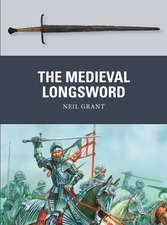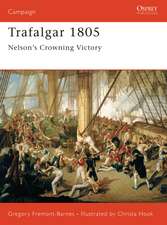Israeli F-15 Eagle Units in Combat: Combat Aircraft, cartea 67
Autor Shlomo Aloni Ilustrat de Chris Daveyen Limba Engleză Paperback – 6 dec 2006
Post-Yom Kippur diplomacy enabled Israel to purchase the F-15 Eagle, which was then the world's best air-to-air fighter. For the first time in its history the IDF/AF could operate a fighter that was a full generation ahead of all opposing interceptors in the region. The first 'Kill' F-15 Baz (Buzzard) arrived in Israel in December 1976, and three years later it got the chance to prove its worth in combat. Israeli Baz pilots were credited with 12.5 kills between 1979 and 1981, with 33 victories following during the June 1982 Lebanon War. A further 4.5 kills followed in post-Lebanon War skirmishes. Despite all of this combat, no Israeli F-15 has ever been lost to enemy action.
Once the jet secured air superiority and deterrence had been achieved along the Israeli borders, the IDF/AF went on to explore the Baz's long-range attributes and as air-to-ground capability. As an example of the former, Israeli F-15s escorted F-16 strike aircraft all the way to Iraq's nuclear reactor in June 1981, and in its bomber role, the type flew the IDF/AF's longest ever attack mission in October 1985 when it bombed the PLO headquarters in Tunis. Diplomacy prevailed again in the 1990s when the US government agreed to supply the IDF/AF with the F-15I Ra'am (Thunder) to fulfill the long-range surface-to-surface missile (SSM) mission post-Desert Storm. These aircraft also acted as a counter-balance to the sale of the F-15S to Saudi Arabia. A follow-on to the F-15I purchase was the development of the Improved Baz Avionics Upgrade Program, which saw the integration of many of the F-15I features into the older F-15A/B/C/D. From A to I, the extremely capable, and combat-tested, Israeli F-15 force will continue to deter potential enemies well into the foreseeable future.
Din seria Combat Aircraft
-
 Preț: 107.24 lei
Preț: 107.24 lei - 25%
 Preț: 80.90 lei
Preț: 80.90 lei - 25%
 Preț: 80.73 lei
Preț: 80.73 lei - 24%
 Preț: 72.37 lei
Preț: 72.37 lei - 24%
 Preț: 72.37 lei
Preț: 72.37 lei - 37%
 Preț: 72.37 lei
Preț: 72.37 lei - 24%
 Preț: 81.19 lei
Preț: 81.19 lei - 37%
 Preț: 72.31 lei
Preț: 72.31 lei - 23%
 Preț: 73.25 lei
Preț: 73.25 lei - 24%
 Preț: 72.16 lei
Preț: 72.16 lei - 33%
 Preț: 72.37 lei
Preț: 72.37 lei - 24%
 Preț: 72.37 lei
Preț: 72.37 lei - 24%
 Preț: 72.16 lei
Preț: 72.16 lei - 24%
 Preț: 72.37 lei
Preț: 72.37 lei - 23%
 Preț: 73.25 lei
Preț: 73.25 lei - 24%
 Preț: 76.78 lei
Preț: 76.78 lei - 25%
 Preț: 70.39 lei
Preț: 70.39 lei - 24%
 Preț: 76.58 lei
Preț: 76.58 lei - 24%
 Preț: 76.78 lei
Preț: 76.78 lei - 24%
 Preț: 76.78 lei
Preț: 76.78 lei - 24%
 Preț: 76.32 lei
Preț: 76.32 lei - 20%
 Preț: 85.21 lei
Preț: 85.21 lei - 24%
 Preț: 76.58 lei
Preț: 76.58 lei - 24%
 Preț: 81.19 lei
Preț: 81.19 lei - 24%
 Preț: 81.19 lei
Preț: 81.19 lei - 24%
 Preț: 81.19 lei
Preț: 81.19 lei - 25%
 Preț: 79.22 lei
Preț: 79.22 lei - 25%
 Preț: 80.81 lei
Preț: 80.81 lei - 25%
 Preț: 80.73 lei
Preț: 80.73 lei - 25%
 Preț: 80.73 lei
Preț: 80.73 lei - 29%
 Preț: 81.19 lei
Preț: 81.19 lei -
 Preț: 80.81 lei
Preț: 80.81 lei -
 Preț: 81.27 lei
Preț: 81.27 lei -
 Preț: 80.99 lei
Preț: 80.99 lei - 30%
 Preț: 80.99 lei
Preț: 80.99 lei - 29%
 Preț: 81.19 lei
Preț: 81.19 lei - 29%
 Preț: 81.09 lei
Preț: 81.09 lei - 29%
 Preț: 81.11 lei
Preț: 81.11 lei - 30%
 Preț: 80.73 lei
Preț: 80.73 lei - 30%
 Preț: 80.73 lei
Preț: 80.73 lei - 30%
 Preț: 80.29 lei
Preț: 80.29 lei - 30%
 Preț: 80.29 lei
Preț: 80.29 lei - 30%
 Preț: 80.73 lei
Preț: 80.73 lei - 30%
 Preț: 80.73 lei
Preț: 80.73 lei - 30%
 Preț: 80.29 lei
Preț: 80.29 lei - 30%
 Preț: 80.90 lei
Preț: 80.90 lei - 29%
 Preț: 81.19 lei
Preț: 81.19 lei - 30%
 Preț: 80.81 lei
Preț: 80.81 lei - 30%
 Preț: 80.83 lei
Preț: 80.83 lei - 30%
 Preț: 80.73 lei
Preț: 80.73 lei
Preț: 80.99 lei
Nou
Puncte Express: 121
Preț estimativ în valută:
15.50€ • 16.83$ • 13.02£
15.50€ • 16.83$ • 13.02£
Carte tipărită la comandă
Livrare economică 23 aprilie-07 mai
Preluare comenzi: 021 569.72.76
Specificații
ISBN-13: 9781846030475
ISBN-10: 1846030471
Pagini: 96
Ilustrații: Illustrations (chiefly col.)
Dimensiuni: 185 x 248 x 7 mm
Greutate: 0.31 kg
Editura: Osprey Publishing (UK)
Seria Combat Aircraft
Locul publicării:United Kingdom
ISBN-10: 1846030471
Pagini: 96
Ilustrații: Illustrations (chiefly col.)
Dimensiuni: 185 x 248 x 7 mm
Greutate: 0.31 kg
Editura: Osprey Publishing (UK)
Seria Combat Aircraft
Locul publicării:United Kingdom
Notă biografică
Shlomo Aloni is a prolific aviation historian based in Israel. He is Israeli correspondent for leading aviation magazines in the UK such as AirForces Monthly and International Airpower Review, as well as publications in Spain and Turkey. This is his fourth volume for Osprey, having written Aces 59 and 60 and Combat Aircraft 23. The author lives in Israel, Mid East; 1973-present.
Recenzii
"Shlomo Aloni has done an excellent job of interviewing former Israeli Eagle pilots and cataloguing the early kills of the F-15 in the service of the Israeli air arm... I would certainly recommend Israeli F-15 Eagle Units in Combat as a good introduction to Israeli Eagle operations from 1976 to the mid-1980s." - Steve Davies, Scale Aircraft Modelling (January 2008)













